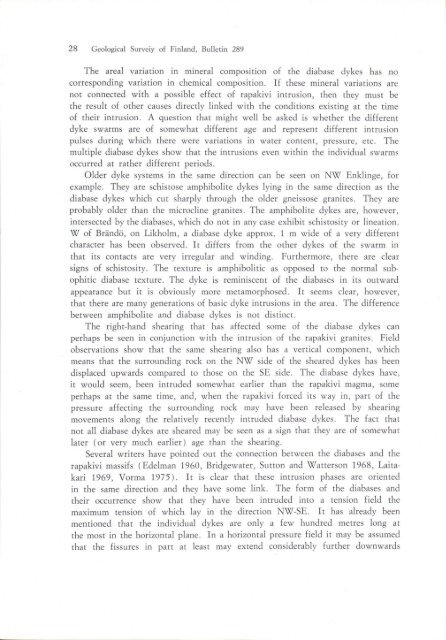Geological Survey of Finland Bulletin 289 - arkisto.gsf.fi
Geological Survey of Finland Bulletin 289 - arkisto.gsf.fi
Geological Survey of Finland Bulletin 289 - arkisto.gsf.fi
Create successful ePaper yourself
Turn your PDF publications into a flip-book with our unique Google optimized e-Paper software.
28 <strong>Geological</strong> Surveiy <strong>of</strong> <strong>Finland</strong>, <strong>Bulletin</strong> <strong>289</strong><br />
The areal variation in mineral composition <strong>of</strong> the diabase dykes has no<br />
corresponding variation in chemical composition. If these mineral variations are<br />
not connected with a possible effect <strong>of</strong> rapakivi intrusion, then they must be<br />
the result <strong>of</strong> other causes directly linked with the conditions existing at the time<br />
<strong>of</strong> their intrusion. A question that might well be asked is whether the different<br />
dyke swarms are <strong>of</strong> somewhat different age and represent different intrusion<br />
pulses during which there were variations in water content, pressure, etc. The<br />
multiple diabase dykes show that the in trusions even within the individual swarms<br />
occurred at rather different periods.<br />
Older dyke systems in the same direction can be seen on NW Enklinge, for<br />
example. They are schis tose amphibolite dykes lying in the same direction as the<br />
diabase dykes which cut sharply through the older gneissose granites. They are<br />
probably older than the microcline granites. The amphibolite dykes are, however,<br />
intersected by the diabases, which do not in any ca se exhibit schistosity or lineation.<br />
W <strong>of</strong> Brändö, on Likholm, a diabase dyke approx. 1 m wide <strong>of</strong> a very different<br />
character has been observed. It differs from the other dykes <strong>of</strong> the swarm in<br />
that its contacts are very irregular and winding. Furthermore, there are dear<br />
signs <strong>of</strong> schistosity. The texture is amphibolitic as opposed to the normal subophitic<br />
diabase texture. The dyke is reminiscent <strong>of</strong> the diabases in its outward<br />
appearance but it is obviously more metamorphosed. It seems dear, however,<br />
that there are many generations <strong>of</strong> basic dyke intrusions in the area. The difference<br />
between amphibolite and diabase dykes is not distinct.<br />
The right-hand shearing that has affected some <strong>of</strong> the diabase dykes can<br />
perhaps be seen in conjunction with the intrusion <strong>of</strong> the rapakivi granites. Field<br />
observations show that the same shearing also has a vertical component, which<br />
means that the surrounding rock on the NW side <strong>of</strong> the sheared dykes has been<br />
displaced upwards compared to those on the SE side. The diabase dykes have,<br />
it would seem, been intruded somewhat earlier than the rapakivi magma, so me<br />
perhaps at the same time, and, when the rapakivi forced its way in, part <strong>of</strong> the<br />
press ure affecting the surrounding rock may have been released by shearing<br />
movements along the relatively recently intruded diabase dykes. The fact that<br />
not all diabase dykes are sheared may be seen as a sign that they are <strong>of</strong> somewhat<br />
later (or very much earlier) age than the shearing.<br />
Several writers have pointed out the connection between the dia.bases and the<br />
rapakivi massifs (Edelman 1960, Bridgewater, Sutton and Watterson 1968, Laitakari<br />
1969, Vorma 1975). It is dear that these intrusion phases are oriented<br />
in the same direction and they have some link. The form <strong>of</strong> the diabases and<br />
their occurrence show that they have been intruded into a tension <strong>fi</strong>eld the<br />
maximum tension <strong>of</strong> which lay in the direction NW-SE. It has al ready been<br />
mentioned that the individual dykes are only a few hundred metres long at<br />
the most in the horizontal plane. In a horizo ntal pressure Held it may be assumed<br />
that the <strong>fi</strong>ssures in part at least may extend considerably further downwards

















